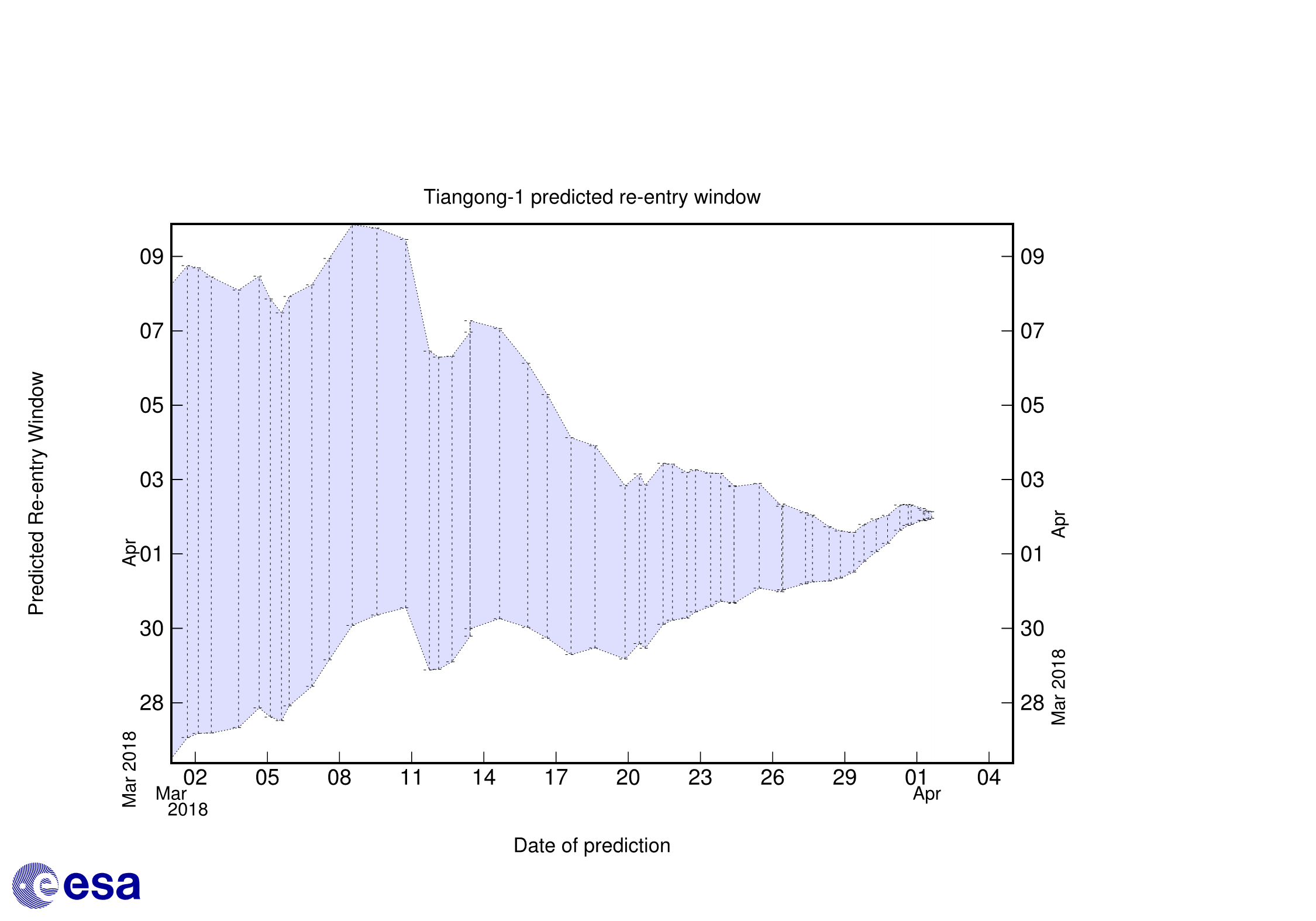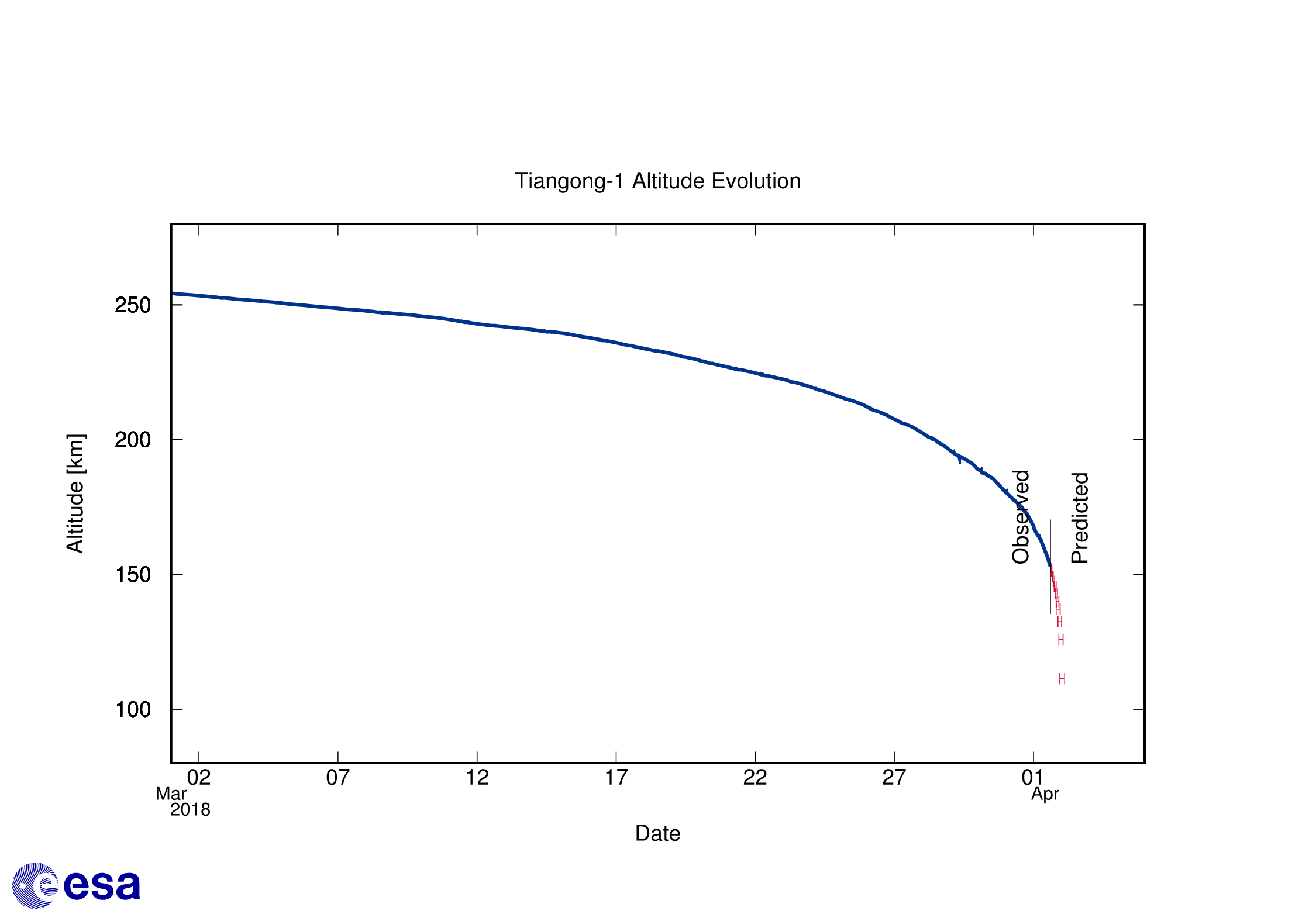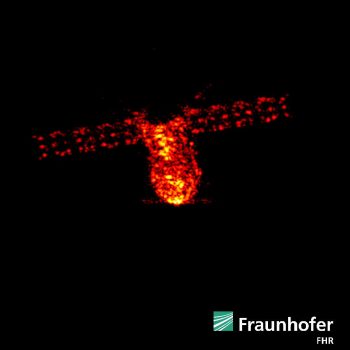
Main Control Room at ESA’s European Space Operations Centre, Darmstadt, Germany. Credit: ESA/P. Shlyaev
With the reentry of Tiangong-1 now forecast to happen within a few hours, ESA’s formal role in the tracking campaign is winding down.
To recall, here’s what’s been happening.
Each year, about 100 tonnes of defunct satellites, uncontrolled spacecraft, spent upper stages and discarded items like instrument covers are dragged down by Earth’s upper atmosphere, ending their lives in flaming arcs across the sky.
While still in orbit, these and many other objects are tracked by a US military radar network, which shares the data with ESA, since Europe has no such capability of its own.
IADC campaign
Around once a year, ESA takes part in a joint tracking campaign run by the Inter Agency Space Debris Coordination Committee, which consists of experts from 13 space organisations such as NASA, Roscosmos, CNSA and European and other national agencies.
With the agreement of all members, Tiangong-1’s reentry was the mission selected for this year’s campaign.
During the campaign, participants have been pooling their predictions of the time window, as well as their respective tracking datasets obtained from radar and other sources, with the aim of cross-verifying, cross-analysing and improving the prediction accuracy for all members.
ESA has been acting as host and administrator for the campaign, as it has done for the twenty previous IADC test campaigns since 1998. A special case for ESA was the campaign in 2013 during the uncontrolled reentry of ESA’s own GOCE satellite.
The China Manned Spaceflight organisation have been providing their own updates on reentry, and additional Tiangong-1 orbit information is here.
ESA’s reentry expertise
In addition to IADC campaigns, it is the task of ESA’s Space Debris team to generate its own independent predictions to ESA Member States and partner civil authorities around the globe.
The team mix in additional tracking information gleaned from European sources, such as Germany’s Fraunhofer research radar near Bonn or telescopes and other detectors run by a mix of institutional and private researchers, to generate reentry forecasts – a challenging and imprecise art.
We’ve been posting ESA’s reentry forecasts regularly here in the blog, and sharing the link via social media.
Getting close
In just a few hours, we’ll be well within the uncertainty window associated with this reentry, and we don’t expect any more forecast updates with any higher accuracy. In other words, we’re at the limit of what we can forecast.
Just over an hour ago, ESA’s space debris team provided their final estimate for reentry, forecasting a window of about four hours between 23:00 UTC on 1 April to 03:00 UTC on 2 April (01:00 CEST on 2 April to 05:00 CEST on 2 April).

Final Tiangong-1 reentry window forecast for 18:00 CEST 1 April Credit: ESA

Final Tiangong-1 altitude decay forecast as of 18:00 CEST, 1 April Credit: ESA
“With our current understanding of the dynamics of the upper atmosphere and Europe’s limited sensors, we are not able to make very precise predictions,” says Holger Krag, head of ESA’s Space Debris Office.
Holger says that there will always be an uncertainty of a few hours in all predictions, and that even just a day or so before any reentry, like now, the uncertainty window can be very large.
“The high speeds of returning satellites mean they can travel thousands of kilometres during that time window, and that makes it very hard to predict a precise location of reentry.”
Spotting reentry
It is likely that the pending reentry of Tiangong-1 will occur over water, probably unseen by anyone (although possibly detected by radar or other sensors).

Tiangong-1 seen at an altitude of about 161 km by the powerful TIRA research radar operated by the Fraunhofer Institute for High Frequency Physics and Radar Techniques (FHR) near Bonn, Germany. Image acquired on the morning of 1 April 2018, during one of the craft’s final orbits. Credit: Fraunhofer FHR
Our planet is a big place, mostly covered by water, and if any pieces survive the fiery reentry, these are unlikely to be found by anyone, sinking instead to the bottom of some ocean, or landing far from human habitation.
If you do witness the event, we’d certainly like to see any images you get.
These will help ESA’s debris team conduct their post-reentry analysis, and improve models and forecasts for future.
We need the time, your location (GPS coordinates fine) and – ideally – the direction in which you were facing when you saw any arc across the sky.
You can share your photos via Twitter (just tag @esaoperations), or mail them to esoc.communication@esa.int. We’ll reply for a confirmation and any follow-up.
In the unlikely case that you find a piece of debris on ground, leave it alone and inform your local authorities.
Our final word comes from last week’s web article, which closed with an observation worth repeating:
Since 2009, ESA has been developing software, technologies and precursor systems to test a fully European network that would provide independent data on the risks from spaceflight.
“Today, everyone in Europe relies on the US military for space debris orbit data – we lack the radar network and other detectors needed to perform independent tracking and monitoring of objects in space,” says Holger Krag.
“This is needed to allow meaningful European participation in the global efforts for space safety.”

Discussion: 15 comments
Hello, with the current forecast for re-entry approximately between 01 and 05 CEST, the last three orbits or so, for Tiangong 1 are now well established. While the probability of a debris fall in the northern Mediterranean basin is still very low, it does stand an a chance of a “hit” by an observable shower. Can ESA facilitate observations by communicating clear forecast tracks for these three orbital periods, while reassuring the “affected” populations ?
Very interesting – thank you! This is a subject we perhaps should all have greater interest in looking forwards.
Yes, I know, the calculated probability of being hit is very low. Still: feelings and fears cannot be calculated – and: at least in my business I made the experience, fat tails are more often encountered than originally expected by calculatory means.
Therefore I will be happy and feel safer, once this piece is hopefully safely down! Especially as very soon after the (currently) calculated „crash“ I will be up in the air and flying into the predicted belt of a possible go-down. Huh!
Thank you for this informative page and the updates of the past days! Finally it is still knowledge and information which can fight (even if not fully erase) fear.
Best Regards, Miuh
The probability of being struck by a piece of this satellite is millions of times lower than the probability that you will be struck by lightning in a full year.
I f you go to one of the sites that keeps track of such things, you can see the current orbit projection and estimate if future orbits will pass anywhere close to you.
“In the unlikely case that you find a piece of debris on ground, leave it alone and inform your local authorities.” Loooool very funny, if i find sattelite debris i am keeping it as a souvenir or sell it on ebay for profit
There was someone that was convicted of doing just that sometime in the fairly recent past.
An almost universal international agreement states that any debris belongs to the country that owns the deorbited object. That same agreement states that the owning country is also responsible for any damages caused by the re-entry.
If we can’t do any better at predicting the timing of something that has been orbiting our planet, falling from space
What are we going to do with a meteor shower when it arrives on our back door?
We cannot predict uncontrolled entries (such as this one) even a few orbits before the re-entry actually occurs.
There are a number of reasons for this – unknown vessel aerodynamics, often unknown assembly sizes and densities, atmospheric density at various altitudes due to solar wind/CMEs etc. Remember that the atmosphere extends many hundreds of miles above the surface. Low orbit objects like this and the ISS, are periodically boosted to a higher orbit. Unfortunately, that has not been possible for about two years with this object, so atmospheric drag is slowly causing it to descend.
Somewhere around the time it descends to 100 km, the aerodynamic drag will become so great that it will never make another orbit.
Another reason why the location of an uncontrolled reentry cannot be predicted – even on the final orbit, is that part or all of the craft can “skip” in the upper atmosphere – meaning it would go further than expected.
Meteors are debris from icy comets and the particles are very small – so none of them reach the ground except as very fine dust. There are over a dozen meteor showers every year.
The major worry is a fairly small undetected asteroid, such as the one that exploded over Chelyabinsk. If it had entered the atmosphere at a steeper angle, it might have caused major damage when it struck the ground.
What does eas stand for?
What does esa stand for?
It is probably a French term, but I just call it the European Space Agency.
Thanks for your tireless efforts to keep the world updated to the utmost of your abilities!
“This is needed to allow meaningful European participation in the global efforts for space safety.”
Why is this “meaningful participation” important? What is wrong with accepting American generosity?
Amazing that the entire Europe couldn’t establish a radar network capable of detecting space debris, whereas the US was able to do it all alone!! how embarrassing is that Europe!
That’s not true! I live in the US
& I have had to rely on Europe for legit information about Tiangong 1. The only state in the US whom even took any action
to alert it’s residents was the Gov of Michigan; cudos to him!
Thank You ESA-for caring for other people around the GLOBE
Whom DO care about attaining indormation and the relentless hours of research and investigation to do so!